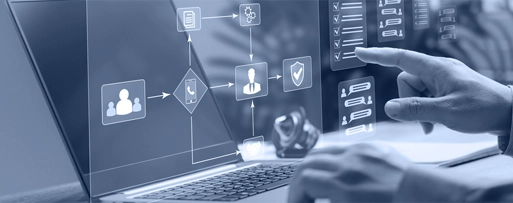Claims Management: Your Definitive Guide
A claim can have very different results, depending on how quickly and efficiently it is handled. Not only can the process have a significant impact on your end cost, but the experience itself can play a pivotal role in how customers view your organization. Even organizations that prioritize claims management can almost always find room for improvement.
Claims are a high-stakes game. Just a 1% reduction in claims costs can add a sizable bump to your bottom line. And more than just hard dollars are involved. All it takes is one mishandled claim that goes viral to inflict lasting reputational damage.
An efficient claims management process can lead to better outcomes both for organizations and claimants. Modern software can streamline the entire claims process, from initial submission through final settlement, using automated processes, advanced analytics, and convenient tracking.
Adjusters have everything they need right at their fingertips to resolve claims faster and more accurately. And in some cases, software can take over the claims management process altogether with AI-assisted claims auto-adjudication and straight-through processing.
You also get direct access to a gold mine of data collected on each and every claim, which can be used to optimize operations, enhance customer service, reduce fraud, and lower expenses.
Whether you intend to manage your own claims or manage claims on behalf of others, here’s what you need to know about efficient claims management – and how to decide if an upgrade is in order.

What Is Claims Management?
Claims management is the process insurers, self-insured companies, third-party administrators, and other organizations take to handle a claim from when it is initially filed through final settlement.
The claims management process can be a significant administrative burden. The sheer complexity of handling diverse claims, adhering to complicated jurisdictional regulations, keeping track of supporting documentation, generating accurate reporting, and identifying high-cost claims can be overwhelming to adjusters and time-consuming to execute.
Having the people, processes, and technology in place is essential to the success of a claims management ecosystem. You need systems to gather all relevant information, simplify communication, ensure that all regulations are followed, and protect against fraud. Outdated legacy or paper-based systems slow the process to a crawl – and add frustration for adjusters and customers.
Some organizations opt to take control over the entire claims lifecycle by self-administering their claims. The decision to self-administer, however, is not one to be taken lightly. Indeed, initial expenses could exceed the cost of using a third party. You also must have the appetite to take on the additional risk long term since the decision can be costly to reverse.
But if you are up for the challenge, the upside can be significant – that is, if you have the right strategy and tools to pull it off.
The Biggest Challenges for Claims Departments
The need for efficient claims management is becoming more urgent, as claims continue to increase in volume, severity, and cost. And the pressure is building.

External forces:
- Extreme weather, including hurricanes, extreme cold, draught, and flooding
- Higher repair costs for damage to property and vehicles
- Talent shortage of experienced adjusters capable of handling complex claims
- Customer expectations for self-service submission, easy tracking, and speedy resolution

Internal forces:
- Increased leakage when subrogation opportunities are missed
- Inaccurate case reserves, either too low or too high
- Inefficient claims prioritization to identify which claims need immediate attention
- Inability to capture intelligence from all claims data, especially that which is unstructured

Why You Need a High-Performing Claims Management Process
Customer expectations are higher than ever. And if you don’t deliver, your reputation could go down faster than you can say social media.
The best way to keep customers happy – and costs down – is to resolve claims quickly and efficiently. What defines “quickly and efficiently,” however, is constantly evolving. As the saying goes, today’s innovation is tomorrow’s expectation.
The big question is are your tools up to date? Systems that rely on aging technology can be cumbersome to use and costly to maintain. It takes time to manually integrate data housed in separate systems. It takes time to wait for IT to figure out yet another patch to keep the system up and running. It takes time to comply with federal and jurisdictional regulations. It takes time for an outdated system to perform for any type of analysis beyond the most basic reports.
Every delay adds to the cost. Plus, the information you do get from these systems can be so unreliable that you end up making decisions based on gut instinct instead of verifiable data.

Use important indicators such as lag time, litigation rates, average claim duration, severity, closing ratio, aged-claim counts, to determine how well your claims program is performing.

Research has shown that the cost of a claim is nearly 40% greater if the claimant delays reporting the claim by as few as four days.
The High Cost of the Status Quo
If you quantify the actual cost of those system deficiencies, inefficiencies, and inaccuracies, you will likely discover that you are spending more to keep the old system running than you would for new claims management software. And how much are those trust-your-gut decisions costing you?
To manage claims successfully, you need a deep understanding of the claims process, a knowledgeable team, and sophisticated software. Older systems often struggle to keep up with the advanced analytics, forecasting, system integration, data security, and ad hoc analysis so in demand today.
Ironically, many legacy systems are still in use expressly to save money – when in fact, these systems are often more expensive than new technology because of maintenance and data deficiencies that put you at an extreme disadvantage for administering claims effectively.
Exceed expectations by looking ahead at best practices and embracing change – whether that involves new technology, new processes, or new vendors. Organizations that are able to accomplish this will enjoy:
- Greater customer satisfaction
- Higher productivity
- More consistent loss costs
- More reserve stability
- Improved regulatory compliance
- Better pricing accuracy
- Lower claims costs
Reducing claims cost by as little as 1% can make a big difference in your bottom line.

If It Isn’t Recorded, It Never Happened
Emails can get lost or misfiled. Tasks can get missed or forgotten. If an action isn’t recorded in the claim file, don’t consider it done.
There are a lot of moving parts with a claim, so diligently record everything you can within the claim file – including adjuster notes, medical diagnosis, reserves, and settlement authority. That way, everyone involved knows exactly what has been done and who did it. Claims managers also can see the current status of a claim, check reserve or settlement requests, and review notes to see if everything possible has been done to mitigate the situation.
How to Diagnose Claims Management Inefficiencies
A single claim can involve a multitude of people, systems, and vendors as it winds toward resolution. A high-performing claims process minimizes the number of touchpoints, eliminates unnecessary steps, and breaks down silos. To streamline your claims management process, seamlessly connect all systems, strategies, and people.
- Map out the entire claim process. This gives you the opportunity to think critically about each step.
- Diagnose inefficiencies. Systems that can’t talk to each other, excessive lags in response time, and overworked employees all add to the cost of the claim.
- Develop an action plan to eliminate waste. Automating routine tasks – and even straightforward claims – can add consistency and speed to the claims process.
Analytics can tell you when to bring in outside help to manage work levels, add expertise, or get someone geographically closer to the situation. Analytics also can be used to route simpler claims to less-experienced adjusters, freeing up seasoned adjusters for the most complicated claims. For maximum impact, focus first on key processes like return to work and reserve management and continue from there.
Inefficiencies make unhappy claimants. Whatever can be done to streamline your process to improve customer service is money well spent.
Those able to leverage data at first notice of loss dramatically improve their claims management process. The ability to capture image and text data and apply analytics at the outset can help guide a simple claim to straight-through processing and a more complex claim to an experienced claims professional.
AI in Claims Management
Artificial intelligence in some form has long been used to analyze claims, automate processes, and prioritize tasks. Today’s generative AI, however, offers the opportunity to supercharge those efficiencies and redefine many claims management practices with its ability to process human language, summarize complex topics, and perform analysis at lightning speed.
The greatest potential for AI in claims management software is with data. A massive amount of data is collected on each claim – the majority of which is unstructured. Until now, the industry has struggled to extract insight from that data and put it to good use.
Today’s generative AI can quickly analyze huge data sets, identify patterns too subtle for humans to see, and answer questions based on what it has learned. AI tools can make more precise predictions, improve customer interactions, and deliver more personalized service. It can also help better calculate loss reserves and estimate how much money is left for future claims.
Using predictive analytics to create a claims severity score ensures that priority claims receive priority treatment. High severity and more complex claims are assigned to the most qualified adjusters while low exposure claims are channeled to less experienced adjusters or auto-adjudicated and settled.

As much 97% of claims data is unstructured in the form of adjuster notes, medical records, police reports, photos, and videos.
Predictive modeling in workers’ comp
AI is particularly useful with workers’ compensation claims. Predictive modeling can accurately forecast which injured workers are most likely to struggle with returning to work, which claims could turn into something severe, and which claims need further investigation.
The insight gained with AI can make a big difference to both injured workers and the organization. Knowing what is ahead can help prioritize resources, get extra support to those who need it, and avoid costly blunders. When claims close faster, the result is usually a better outcome for everyone.
Here are seven predictive models that are helping claims professionals identify potential problems, intervene early, and achieve better results:
Early severity.
Getting the right resources to high-risk injured employees early in the process can change the trajectory of the claim. Early-severity models analyze injury type, claimant demographics, and initial medical assessments to predict the severity of a workers’ comp claim and flag those with the potential to become high risk and/or high cost. That way, you can direct resources – e.g., rehabilitation programs, medical treatments, and additional support – to those claims that will most benefit from early intervention, which will reduce costs and improve outcomes.
Fraud detection.
Workers’ compensation fraud costs the industry approximately $34 billion per year. Fraud detection models sift through claims data for suspicious patterns and anomalies to identify common fraud indicators such as inconsistent information, excessive medical treatments, or repetitive claims from the same individual. Suspicious claims are flagged for further investigation.
Return to work
The key to a successful return-to-work program is speed – respond quickly to resolve quickly. Return-to-work models analyze the nature of the injury, medical treatments received, and other factors to predict the likelihood of an injured employee returning to work within a specified timeframe. This insight can help jump-start customized rehab and workplace accommodations to smooth reintegration. Quick action also aids in employee recovery, productivity, and morale – while reducing costs to the organization.
Subrogation.
Claims leakage – from third-party liability, inefficiencies, or errors – costs millions each year. Subrogation models analyze accident reports, liability information, and other details to identify claims where a third-party is at fault. The models also can determine the likelihood of successfully recouping costs of already-paid claims so you can prioritize your efforts.
Medical cost projection.
Medical costs – including facilities, physician costs, equipment, and supplies – account for the majority of workers’ comp costs. Medical cost projection models analyze historical claim data, medical treatment patterns, and healthcare cost trends to estimate the total liability of the claim to help allocate reserves appropriately.
Litigation risk.
Litigated workers’ comp claims are 388% more expensive than non-litigated claims. Injured employees who hire attorneys to handle their workers’ comp cases tend to stay on disability longer, which increases costs and duration of the claim. Litigation risk models analyze complexity, previous litigation history, and jurisdictional considerations to assess the likelihood of a claim escalating into a legal battle. AI-enabled litigation risk models also can help target early settlement negotiations, identify candidates in need of thorough investigations, and flag claims that may need specialized legal support.
Predictive safety.
What if you could identify high-risk areas, anticipate injury trends, and proactively fix problems to prevent injuries from happening in the first place? Predictive safety models estimate the likelihood of future workplace incidents and injuries by analyzing historical accident data, near-miss reports, and safety inspection findings. The analysis can help prioritize safety initiatives, allocate resources effectively, and implement targeted interventions.
The 24-Hour Rule
Claims that drag on cost more – and that’s particularly true with workers’ compensation claims. Every injured person wants to feel empathy that their employer is as concerned about their injury as they are. And any lag in response time sends a message that you don’t care.
Employees who don’t feel like their injury is being taken seriously are more likely to seek legal counsel – which can exponentially increase the cost of a claim. Add lost-wage payments to the tab anytime an employee misses more than three days of work.
To increase your odds of a good outcome, aim for making initial contact within 24 hours. And have a consistent, robust return-to-work program to get them back as quickly as possible to whatever job capacity makes the most sense.
What Can Software Do for Claims Management?
Modern claims management software is designed to move every claim through the system with maximum efficiency to resolve even the most complex claims quickly, easily, consistently, and fairly.
Spreadsheets can do the job done just fine if you have a relatively small number of claims. Simply tracking a claim’s status, however, is not enough in today’s world. To effectively manage a large number or complex claims, you need to have efficient and reliable technology.
The latest claims management platforms support the entire claims lifecycle – first notice of loss, claims setup, assignment, investigation, reserves, litigation, settlement, regulatory compliance, and reporting – all within a single system.
Top solutions provide automated workflows for best-practice consistency, seamlessly integrate data from third parties, and are quickly and easily modified to meet your needs. The most advanced solutions also offer predictive analytics to drive better decisions and implement more strategic initiatives.
Today’s claims management software delivers:
Better visibility. Consolidating people, systems, and claims data from multiple sources into one location makes it easier and faster to uncover trends and relationships between disparate pieces of information.
Streamlined processes. Intuitive mobile forms, automatic alerts, real-time access to data, integration with third-party systems, and instant data validation boost both efficiency and accuracy.
Earlier intervention. Automated processes can easily analyze huge amounts of data to identify potential problems claims early on before a seemingly simple claim spirals out of control.
Reduced fraud potential. Current technology is much more sophisticated than humans at detecting a claim’s potential for fraud.
Wiser use of resources. Software can automatically route the most complex claims to seasoned adjusters for investigation and management, while routing routine claims to less experienced handlers.
Reduced leakage. Increased jurisdiction acceptance rates can avoid fines and penalties.
Increased productivity. Advanced reporting and analytics can track both individual adjuster performance and overall claims handling efficiency, and benchmarking alerts can notify you when a claim deviates from the expected path.
Stronger customer connections. Customers who feel their claims were handled fairly and efficiently are more likely to remain loyal to your organization.
Smarter decisions. An integrated system leverages all relevant data so you can make educated decisions faster – the impact of which becomes even more profound over time.

New Versus Old: Weighing Your Options
Purchasing new claims management software is by no means your only option. You also can upgrade your existing system. Here’s a look at how those options compare:
| Option | Advantages | Disadvantages |
|---|---|---|
| Next generation claims management software |
|
|
| Upgrade current system |
|
|
Key Components of Software for Claims Management
Even the best software is virtually useless if it’s too difficult to use. Make sure your software is quick to learn, intuitive to use, and enjoyable to work with. In addition, it should be accessible from a variety of devices – phone, tablet, laptop, and desktop – so claim data can be captured quickly and accurately by anyone.
Claims management software can cover a range of related activities. Some systems are a “one-and-done” type, while others allow you to start small and bolt on other capabilities as needed. Some of the most popular uses include:
| Use | Function | Look for .. |
|---|---|---|
| Audit | To gauge progress, ensure compliance, and evaluate results against past audit scores |
|
| Intake | To streamline claim and incident entry |
|
| Claims Regulatory Compliance | To monitor regulations and electronic reporting requirements |
|
| Data Transformation Services | To transform and validate data from external systems |
|
| Document Management | To electronically house all files related to claim activities |
|
| Electronic Report of Injury | To manage complex electronic filings for FROI and SROI for state workers’ compensation requirements |
|
| Reporting & Analytics | To create meaningful tables and charts |
|
| Reserve Management | To create and maintain financial integrity throughout the life of the claim and to evaluate loss exposures |
|
| Return to Work | To manage the return-to-work process to get ill or injured employees back to work quickly and safely |
|
| Workflow Management | To automate routine tasks, notifications, and alerts |
|
How to Get the Most Out of Dashboards
Dashboards are essential for managing claims effectively.
A well-executed dashboard shows you everything you need to assess the health of your claims operation at a glance. You can find answers and visualize KPIs in real time. And graphics make complex information instantly understandable.
Building an effective dashboard starts with deciding which metrics to display. What information do you need to make sure claims are being handled efficiently? Keep your dashboard focused on the six to eight metrics you need to do your job effectively. Any more than that will make your dashboard cluttered and hard to read – which defeats the whole purpose.
Commonly tracked KPIs (daily, weekly, or monthly) include:
- New losses (which can be subdivided by incidents, claims, suits, and lines of coverage)
- Severity (average incurred per claim, top 10 large losses by location or cause)
- Closed claims (closing-ratio percentage)
- Average claim duration
- Average cost per claim
A good dashboard:
- Acts as the nerve center of your claims operation. Critical information is all in one place and well organized for quick answers.
- Tells a clear story. Graphics are more than just eye candy. They put context around the data and convey specific facts in a more effective way than numbers in a table can.
- Follows the 5-second rule. You should be able to find what you’re looking for in 5 seconds or less. Put the most significant metrics at the top of the screen and more detailed information at the bottom for the most intuitive layout.
- Cuts the clutter. Include everything you need – and nothing that you don’t. Use your space wisely, and group data logically.
Even the best dashboard is worthless, however, if it isn’t combined with thoughtful analysis and attentive follow-up.
Claims Management Workflows
A claims management system is only as good as the process it supports. Before you sign on for new software, it’s essential that you understand all the intricate details—not just have a general idea – of your claim process.
Are there any redundancies, gaps, or inefficiencies that need to be addressed or eliminated? Do your adjusters regularly need to connect with HR, finance, accounting – or third parties such as ODG, ISO, OFAC, document management, and regulatory compliance?
Directly integrating with the internal and external systems used most can significantly reduce the amount of time adjusters spend gathering, prepping, rekeying, and submitting data. Think through your workflows and identify any issues early because making large-scale changes after implementation can be time-consuming and expensive.
Here are some of the processes to map out in advance:
- Notice of loss reporting
- Electronic claim-file screen configuration
- Data management
- Claims case management
- Document management
- Reserve management
- Payment process
- Reporting needs
- Regulatory compliance
- Third-party provider integration
- Reinsurance reporting needs
- Policy management
- Integration with other data sources
Regulatory Protection
Navigating the complex rules and regulations to stay in compliance is a big job with huge consequences. The right claims management software – and vendor – can help you avoid steep fines and keep you in compliance by proactively monitoring legislation and regulations, automating required regulatory functions, and resolving complex regulatory issues.
How to Select a Software Vendor for Claims Management
There is no shortage of vendors that say their software can administer claims efficiently. But sorting through these assertions to find the vendor that truly understands your needs, processes, issues, and pain points can be tricky. It takes plenty of research to uncover the truth about how well each vendor matches up.
Here are some considerations to help you narrow down the field:
10 Questions to Ask Claims Management Software Vendors
- How easy and convenient is the system to review claims, enter notes, set reserves, and approve payments?
- How knowledgeable are you about our industry?
- Will your software easily integrate with all the necessary internal and external data sources, such as ODG, ISO, OFAC, CMS?
- Is the system cloud-based, with access available 24/7 from anywhere on any device?
- How long will implementation take?
- Does the software support multiple insurance lines?
- What security measures are in place to protect my data?
- What type of customer service support do you offer?
- How long have you been in business?
- What is the cost?
Separate Vendors from True Partners
The claims vendor list is long – attorneys, medical professionals, auto-repair shops, contractors, medical case managers, and the all-important TPA. Not only are you spending good money for their services, but vendors also represent your company. And both your reputation and your bottom line are at risk.
Strengthening these vitally important relationships can both lower costs and improve customer service. Quantitative measures – claims resolution costs, timeframes, closing rates, etc. – are certainly important. But it’s the qualitative factors that can make or break the relationship.
Strong vendor relationships can balance workloads, control costs, and drive efficiency. The key is to build a collaborative, cross-functional team that works well together. Here are four tips to set you up for success:

Get to know vendors personally.
Having a human connection paves the way to open communication and constructive collaboration. Meet the people who are working on your claims and get to know them personally. A little old-fashioned rapport with who is on the other end of the line also makes it much easier to deal with any issues that do come up.

Establish clear expectations.
Spell out realistic, clear, and concise instructions, and include all the right controls for response time, reserve increases, settlement authority, etc. And make sure the vendors’ employees are well trained in executing those instructions.

Hold vendors accountable.
Hold vendors accountable. Vendors need to have skin in the game. Make sure they are hitting key metrics and are following your instructions. And know when to step in to keep things on track. It’s also important to monitor vendor performance to reduce claim leakage and expense on your bottom line.

Seamlessly integrate systems.
Seamlessly integrate systems. The more vendors that can automatically integrate with your system, the better. Direct data feeds eliminate the need to manually input data – which reduces human error, simplifies communication, and frees up staff for more valuable tasks.
Trouble in Paradise?
Vendor relationships can quickly deteriorate because of:

Lack of transparency. It’s frustrating if you don’t know how and where your claim dollars are being spent.

Inconsistent performance. What good are service instructions if the vendor is making it up as they go along?

High turnover. A high-turnover rate among adjusters at a TPA, for instance, can be a sign of deeper trouble.
Switching vendors can be costly and disruptive, so make that a last resort. Instead, recognize early signs of trouble, and do everything you can to get a derailed relationship back on track. The best option is to avoid trouble in the first place by selecting vendors that match your company’s values and maintain regular and direct communication to keep everything moving along smoothly.
How to Build Support for New Software
The longer a claim stays in the system, the more expensive it usually gets. So, anything you can do to hasten the claims process will likely reduce costs.
New claims management software can help you resolve claims faster with better outcomes. Sophisticated capabilities give you the ability to detect subtleties in the data – for potential fraud, litigation, subrogation, and other troubling claim trends – and to comply with regulatory reporting requirements. And claims more likely to drive up expenses can be routed to expert resources for better productivity and performance.
The right technology will help you take advantage of all the claims data you’ve been collecting. Advanced analytics can transform data into insights that will help you make better decisions, root out fraud, reduce cycle time, and allocate resources more effectively. Making good use of dashboards and reporting keeps your thumb on the pulse of the claims process, while improving communication with top management, and enhancing collaboration among the entire claims operation.
Technology is also the springboard for improving other aspects of your claims process. Strengthening your relationships with vendors – including seamlessly integrating with their systems – can yield impressive results. And it’s worth taking another look at your processes with an eye toward automation where appropriate to add consistency and speed to the claims process.
Justifying a purchase when you already have a system in place, however, can be a challenge. Start by quantifying the true cost of the current system. How much time and money are you spending to patch, upgrade, or revise the software? How much time is wasted logging on to separate systems or tracking down necessary data? How much time is spent manually entering data?
Attaching numbers to those delays and inadequacies can cast that system in a whole new light. And then there are costs that are harder to quantify. What is the added cost of claims delayed by system breakdowns? How much are your decisions unsupported by timely and accurate reports costing? What is the cost of opportunities missed because of incomplete or inaccurate data? And do you trust your current system to properly maintain records – or are you keeping back-up paper files “just in case”?
Legacy systems, budgetary constraints, and overworked employees all can make change an uphill battle. But even small improvements in the way claims are handled are worth it when you add up the potential savings – which goes right to the bottom line.
And that is sure to be welcome news to the C-suite.
For more on taking your claims management process to the next level, download our ebook, Claim Success: How to Achieve Excellence in Claims Management, and check out Riskonnect’s Claims Administration software solution.

